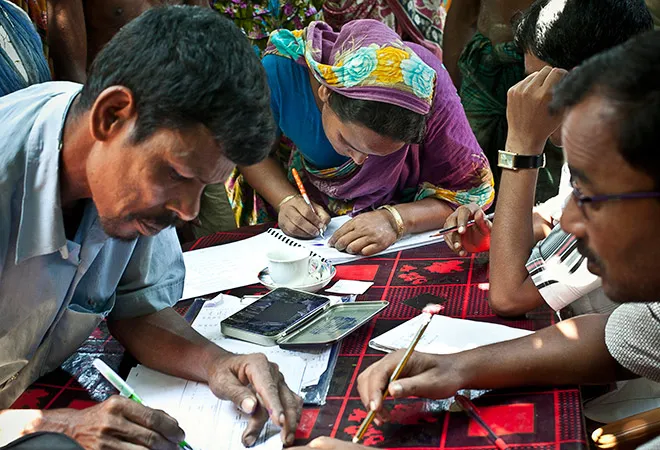
The issue of National Register of Citizens of India (NRC) has now became a focus of the electoral debate after the BJP in its manifesto promised to implement it nationally. NRC intends to record genuine Indian citizens and identify the infiltrators. Many of the bordering States, primarily in the North East, are facing the problem of infiltration from the neighbouring countries, especially, Bangladesh. At present, NRC is applied only in Assam, where demography has changed following illegal infiltration from Bangladesh. Given the size of India’s population, implementation of the NRC will be a mammoth task and demands a detailed analysis of the likely challenges it will face.
At present, NRC is applied only in Assam, where demography has changed following illegal infiltration from Bangladesh. Given the size of India’s population, implementation of the NRC will be a mammoth task and demands a detailed analysis of the likely challenges it will face.
Infiltration from Bangladesh has been a cause of socio-ethnic tensions in the bordering states as the locals are apprehensive of being marginalised in their home state. In the 1980s, Assam had witnessed six-year long violent agitiation against the illegal migrants. Established measures such as diplomatic and border management efforts failed to bring any results. The two main reasons for this are: 1) Bangladesh does not recognise any infiltration taking place from its territory to India; 2) The porous border between India and Bangladesh hinders effective border management. Tackling infiltration from Bangladesh demands alternative solution, hence there are doubts whether the NRC alone could solve the problem.
NRC in Assam
The NRC, being implemented in Assam, has its roots in the Memorandum of Settlement or the Assam Accord signed between the Assam State Students Union and the Government of India in 1985. The accord was an outcome of the violent anti-migrant movement of the 1980s and contained various clauses to curb illegal migration. The accord, however, could not solve the issue of illegal migraton. In another effort to check the problem, the NRC was initiated in 2010 as a pilot project in two districts of Assam -- Barpeta and Kamrup. But this process was stalled after four weeks following the outbreak of violent clashes in Barpeta. The work of the NRC, however, was revived after the intervention of the Supreme Court of India following a petition, submitted by an NGO, Assam Public Works, sought steps for the deletion of the undocumented migrants from the voters roll and updating the citizens' list as a step to control illegal migration. In 2015, the Assam government resumed the work of the NRC under the supervision of the Supreme Court.
The NRC is published in three segments. The first list referred to as the Part Draft was published on the midnight of 31 December, 2017 and it included only 1, 90,10,932 members, out of the 3.29 crore applicants. The second list, termed as the Complete Draft, was published on 30 July, 2018 and included 2,89,83,677 members. It left out another 40,70,707 people out of the list. It is important to note that the list is not the final draft, with the people who were not included in the complete draft having been given an opportunity to file their claims. The expectation is that the number of people that have been excluded will come down in the final list.
Criticism of the NRC
The exclusion of people in such a large numbers has led to criticism of the NRC exercise. People fear that they might become stateless if their names are not included in the list. What is worrying is that is there has been no specific policy in ascertaining their fate. The possibility of deportation to Bangladesh is very bleak as the people excluded from the list should be proven citizens of Bangladesh, and that will require cooperation from that country. Dhaka has been categorical on its stance on the infiltration issue. The option of push-back is neither desired nor helpful in preventing infiltration. Previous experiences indicate that those who were pushed back, returned within few days. Heavy-handedness on this issue could also harm warm ties between India and Bangladesh, an eventuality both neighbors would like to avoid.
The exclusion of people in such a large numbers has led to criticism of the NRC exercise. People fear that they might become stateless if their names are not included in the list.
People from Bangladesh migrate to India primarily to avoid religious persecution, search for better livelihood opportunities, acquire education etc. Initially, the Citizenship Amendment Bill (CAB) 2016 was perceived to give relief to Bengali Hindus, who will be left out of the final list of the NRC. The CAB intends to grant citizenship to Hindus, Sikhs, Buddhists, Parsis, Jains and Christians from Bangladesh, Pakistan and Afghanistan because they have been persecuted in their home country. In this regard, the CAB intends to shorten their period of stay in India from 11 years to 6 years. However, the CAB is facing major opposition in the Northeastern States, with even some of the allies of the ruling Bharathiya Janata Party (BJP), such as the National People’s Party and Asom Gana Parishad, leading these protests. They are also questioning the efficacy of the NRC following introduction of CAB.
Despite protests from many parties and leaders, the BJP in its manifesto has promised NRC at the national level if it is voted back to power. However, while implementing the NRC nationally, cautious introspection is required on finalising the cut-off date for the Indian citizenship. In the case of Assam, the citizenships were granted on the basis of the cut-off date of 25 March 1971. It’s important to note here that the refugees from East Pakistan came and settled in Assam even much after the partition of India in 1947. During the 1950s and 1960s, a large number of Hindus from East Pakistan had come and settled in different parts of the country, particularly in West Bengal and Tripura. The concern is whether the same date as in Assam can be applied for the rest of the country also.
Who is an Indian citizen?
According to the Indian Citizenship Law, a person is an Indian citizen if he/she domiciled in India when the Constituent Assembly adopted the Constitution on 26 November 1949 or if he/she had been in India for at least five years until that date. For those born after the adoption of Constitution, the Indian Citizenship Act 1955 grants citizenship based on the birth date: (i) Anyone born between 26 January 1950 and 1 July 1987 is a citizen by birth; (ii) A person born between 1 July 1987 and 3 December 2004 is a citizen by birth if either of his parents is a citizen at that time; (iii) Those born on or after 3 December 2004 is a citizen if both of the parents are citizens of India at the time, or if one parent is a citizen and the other is not an illegal migrant (a foreigner who entered India without valid documents, or stayed beyond the allowed period).
A unanimous decision on the issue of cut-off dates will be ideal. Arriving at this agreement will require deep introspection both from the state and civil society. There are groups who might argue for providing citizenship to people who came to India between 1950 and 25 March 1971 from both East and West Pakistan -- primarily minorities who came to India to escape persecution. There might also be opposition to such views by some political parties who say it is a partial policy. The controversy over the CAB is a case in point, as some fear the introduction of the NRC might result in serious law and order issues.
The cooperation of the States will be key for the success of NRC. Support of the State governments will be vital, and reaching a consensus on the NRC will be a challenge. Already, State governments like West Bengal have expressed reservations on the issue.
The BJP’s electoral fortunes in the ongoing elections will be a pivotal determinant in the implementation of the NRC across the country. However, politics aside, the NRC is a forward-looking step in documenting India’s citizens and detect and deter infiltrators.
The views expressed above belong to the author(s). ORF research and analyses now available on Telegram! Click here to access our curated content — blogs, longforms and interviews.




 PREV
PREV


